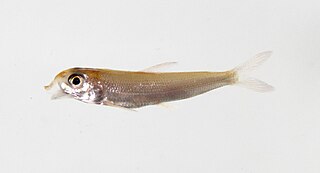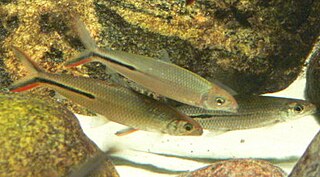
Characidae, the characids or characins is a family of freshwater subtropical and tropical fish, belonging to the order Characiformes. The name "characins" is the historical one, but scientists today tend to prefer "characids" to reflect their status as a by and large monophyletic group at family rank. To arrive there, this family has undergone much systematic and taxonomic change. Among those fishes that remain in the Characidae for the time being are the tetras, comprising the very similar genera Hemigrammus and Hyphessobrycon, as well as a few related forms such as the cave and neon tetras. Fish of this family are important as food and also include popular aquarium fish species.

Hyphessobrycon is a genus of freshwater fish in the family Characidae. These species are among the fishes known as tetras. The genus is distributed in the Neotropical realm from southern Mexico to Río de la Plata in Argentina. Many of these species are native to South America; about six species are from Central America and a single species, H. compressus is from southern Mexico.

Astyanax is a genus of freshwater fish in the family Characidae of the order Characiformes. Some of these fish, like many of their relatives, are kept as aquarium pets and known collectively as tetras. With around 150 described species and new ones being described yearly, this genus is among the largest of the entire order; Hyphessobrycon also has more than 145 species and which one is larger at any one time depends on whether more species have been recently described in one or the other. The blind and colorless cave tetra of Mexico is a famous member of the genus, but its taxonomic position is disputed: Some recognize it as part of the Mexican tetra and this is supported by phylogenetic evidence, but others recognize the cave form as a separate species, A. jordani.

Crenicichla is a genus of cichlids native to South America commonly known as the pike cichlids. They are found in most tropical and subtropical freshwater habitats between the Andes and the Atlantic.

Leporinus is a genus of fish in the family Anostomidae native to South America. The fossil species Leporinus scalabrinii, known from the late Miocene of Entre Ríos in Argentina, has only recently been added to this genus after being misidentified as a species of primate under the name Arrhinolemur scalabrinii for over 100 years.

Moenkhausia is a genus of freshwater fish in the family Characidae native to tropical and subtropical South America. These are medium-sized tetras where the largest species only reach around 12 cm (4.7 in).

Bryconamericus is a genus of characins found in Central and South America.

Creagrutus is a genus of characins found mostly in South America, with one species C. affinis extending into Panama in Central America.

Hemigrammus is a genus of freshwater fish in the family Characidae native to South America and commonly seen in the aquarium trade. These are medium-small tetras where the largest species reach up to around 11 cm (4.3 in).

Jupiaba is a genus of characins from South America. with 27 currently described species:
Knodus is a genus of characins, small freshwater fish from South America.

Characidium is a genus of fish in the family Crenuchidae. They are mainly found in South America, but C. marshi is from Panama. They are small, slender fish that live on the bottom in flowing fresh waters and feed on small animals such as insects.

Curimata is a genus of toothless characins from tropical South America, with 13 currently described species:
Curimatopsis is a genus of small South American fish in the family Curimatidae. They are native to freshwater habitats in the Amazon, Orinoco and Paraguay basins, as well as river of the Guianas.

Cyphocharax is a genus of fish in the family Curimatidae native to South America.

Bivibranchia is a genus of halftooths from tropical South America, with five recognized species:

Hemiodus is a genus of halftooths from South America with the greatest species richness in the Amazon Basin, but also found in the Orinoco, Essequibo, Paraná–Paraguay and Parnaíba River basins. Depending on the species involved, these elongate fish reach a length of 7–30 cm (3–12 in).

Pyrrhulina is a genus of freshwater fishes found in tropical South America. Several of these species are popular aquarium fish.

Iguanodectidae is a family of freshwater fish in the order Characiformes that lives in South America. It is home to the subfamily Iguanodectinae and the monotypic Bryconops clade. Several species in the family, such as the green line lizard tetra, the tailspot tetra, and the orangefin tetra, are sometimes taken as aquarium fish.
















